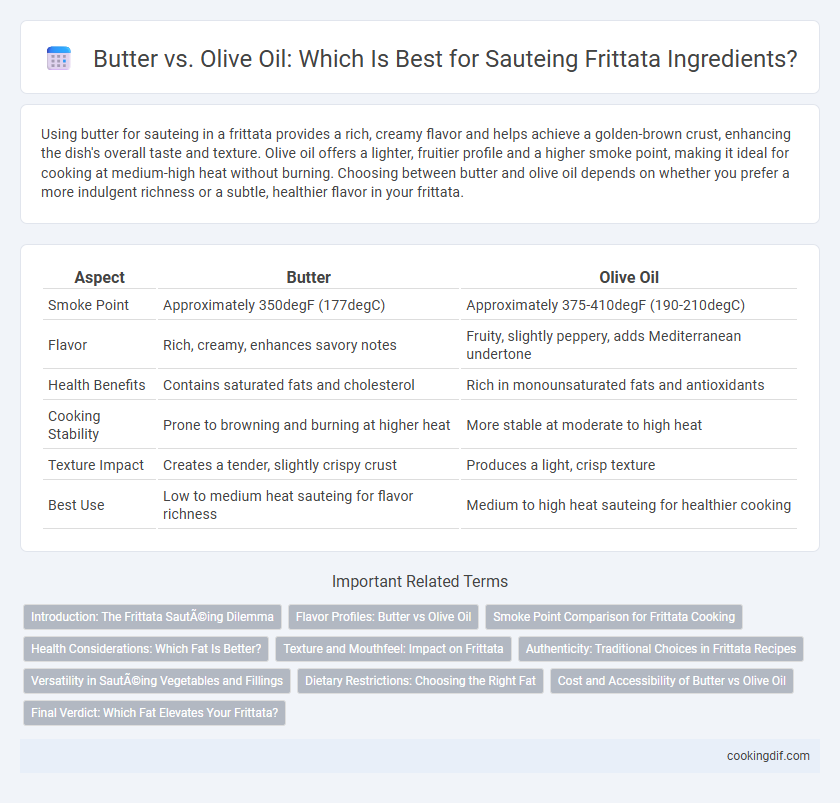Using butter for sauteing in a frittata provides a rich, creamy flavor and helps achieve a golden-brown crust, enhancing the dish's overall taste and texture. Olive oil offers a lighter, fruitier profile and a higher smoke point, making it ideal for cooking at medium-high heat without burning. Choosing between butter and olive oil depends on whether you prefer a more indulgent richness or a subtle, healthier flavor in your frittata.
Table of Comparison
| Aspect | Butter | Olive Oil |
|---|---|---|
| Smoke Point | Approximately 350degF (177degC) | Approximately 375-410degF (190-210degC) |
| Flavor | Rich, creamy, enhances savory notes | Fruity, slightly peppery, adds Mediterranean undertone |
| Health Benefits | Contains saturated fats and cholesterol | Rich in monounsaturated fats and antioxidants |
| Cooking Stability | Prone to browning and burning at higher heat | More stable at moderate to high heat |
| Texture Impact | Creates a tender, slightly crispy crust | Produces a light, crisp texture |
| Best Use | Low to medium heat sauteing for flavor richness | Medium to high heat sauteing for healthier cooking |
Introduction: The Frittata Sautéing Dilemma
Butter and olive oil offer distinct benefits when sauteing vegetables for a frittata, impacting both flavor and cooking performance. Butter provides a rich, creamy taste and browns ingredients evenly at moderate heat, while olive oil delivers a fruity, slightly peppery note with a higher smoke point for sauteing at higher temperatures. Choosing between butter and olive oil depends on desired taste profiles and cooking techniques, balancing buttery richness against the robust, healthy qualities of olive oil.
Flavor Profiles: Butter vs Olive Oil
Butter imparts a rich, creamy flavor with subtle nutty undertones that enhance the savory elements of a frittata, creating a smooth and indulgent texture. Olive oil offers a fruity, slightly peppery taste that adds a Mediterranean brightness, complementing fresh herbs and vegetables without overpowering them. Choosing butter or olive oil for sauteing alters the overall flavor profile, emphasizing either a luxurious mouthfeel or a vibrant, aromatic freshness in the dish.
Smoke Point Comparison for Frittata Cooking
When sauteing ingredients for a frittata, olive oil offers a higher smoke point of about 375-420degF (190-215degC) compared to butter's lower smoke point around 350degF (175degC). This difference means olive oil is less likely to burn or produce a bitter taste during the initial vegetable saute, preserving flavor integrity. However, butter imparts a rich, creamy taste, so some chefs combine both to balance flavor and cooking performance in frittata preparation.
Health Considerations: Which Fat Is Better?
Olive oil is rich in monounsaturated fats and antioxidants, making it a heart-healthy choice that supports cholesterol reduction and reduces inflammation when sauteing for frittatas. Butter contains saturated fats and cholesterol, which may raise LDL levels and pose risks for cardiovascular health if consumed excessively. For a nutrient-dense and health-conscious frittata, olive oil provides beneficial compounds without compromising flavor or cooking performance.
Texture and Mouthfeel: Impact on Frittata
Using butter for sauteing in a frittata enhances the texture by adding a rich, creamy mouthfeel and a slight crispness to the edges, creating a velvety interior. Olive oil, with its lighter consistency and fruitier notes, lends a smoother, slightly silky texture without overpowering the dish, resulting in a more delicate bite. The choice between butter and olive oil influences the frittata's final texture, balancing richness and lightness according to flavor preference and desired mouthfeel.
Authenticity: Traditional Choices in Frittata Recipes
Butter is often favored in traditional frittata recipes for its rich, creamy flavor and ability to create a delicate, golden crust. Olive oil, while common in Mediterranean variations, imparts a distinct fruity aroma that aligns with regional authenticity, particularly in Italian and Spanish frittatas. Choosing between butter and olive oil depends on the desired flavor profile and adherence to specific cultural culinary practices.
Versatility in Sautéing Vegetables and Fillings
Olive oil offers a robust flavor and high smoke point, making it ideal for sauteing a variety of vegetables and fillings in a frittata, enhancing taste while preventing burning. Butter provides a rich, creamy texture that complements delicate ingredients and delivers a golden color, though it has a lower smoke point. Combining butter and olive oil can maximize versatility, balancing flavor depth, texture, and heat tolerance for perfect sauteed fillings.
Dietary Restrictions: Choosing the Right Fat
Butter provides rich flavor and a creamy texture but contains lactose and dairy proteins that may not suit lactose-intolerant or vegan diets. Olive oil offers a heart-healthy monounsaturated fat option free from dairy, making it ideal for people with lactose intolerance, dairy allergies, or those following plant-based diets. Selecting the right fat for sauteing in a frittata depends on dietary restrictions, with olive oil favored for its anti-inflammatory properties and butter preferred for its traditional taste and richness.
Cost and Accessibility of Butter vs Olive Oil
Butter often costs more per unit than olive oil but is widely accessible in most grocery stores, making it a popular choice for sauteing in frittatas. Olive oil, especially extra virgin varieties, can be pricier but offers longer shelf life and versatility beyond cooking. Both fats are generally available, though olive oil may be more prevalent in regions emphasizing Mediterranean cuisine, impacting accessibility and cost-effectiveness depending on location.
Final Verdict: Which Fat Elevates Your Frittata?
Butter imparts a rich, creamy flavor and helps create a golden-brown crust that enhances the frittata's texture, while olive oil offers a lighter, fruitier taste with a higher smoke point ideal for even cooking. Choosing butter elevates indulgence and depth, especially when a slightly nutty finish complements the eggs, whereas olive oil suits health-conscious cooks seeking a heart-healthy fat with subtle earthiness. The final verdict favors butter for flavor complexity and browning, but olive oil wins for its versatility and nutritional benefits in sauteing frittatas.
Butter vs Olive Oil for Frittata Sautéing Infographic

 cookingdif.com
cookingdif.com